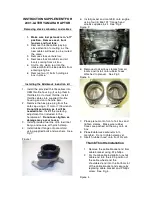
Engine Checks Before Operating
When you have started your engine, let it run for
20 to 30 seconds before you put a load on the engine.
But do not leave the vehicle while the engine is running.
Avoid unnecessary idling of diesel engine equipped
vehicles.
If the engine idles too long, the temperature of the
engine coolant will fall below the normal operating
range. Low engine operating temperature causes
several conditions which affect engine operation and
reduce engine life.
The engine should be permitted to go through a
warm-up period. Operate the vehicle at a minimum of
600 rpm during the warm-up period. During this
period and during operation, the following observations
should be made.
During this warm-up period, check your warning lights
and gages:
•
If oil pressure does not begin to rise within
15 seconds of starting, stop the engine and find the
cause. See Oil Pressure Gage on page 3-32 for
more information.
•
If the engine coolant temperature gage needle goes
into the hot area on the gage, stop the engine and
find the cause of the overheating. See Engine
Coolant Temperature Gage on page 3-30 for more
information.
•
If you have air brakes, the dual-needle air pressure
gage should read at least 115 psi (790 kPa) for
both service systems before you try to move
the vehicle. When air pressure is below 60 psi
(420 kPa), the LOW AIR light will come on and you
will hear a tone alarm. See Brake System Warning
Light on page 3-27 for more information. If the
pressure does not build up or drops during warm-up,
stop the engine and find the cause before you try
to move the vehicle. Recommended air pressure
before driving is 120 psi (830 kPa). See Air
Pressure Gage on page 3-39 for more information.
•
The charging system light should come on when the
ignition key is turned to ON or START and should
go out when the engine is running above idle. If the
light does not go out or comes back on during
normal engine operation, have the charging system
checked right away. (This light tells you if the
generator is not charging; it does not reflect the
condition of the battery.)
•
The voltmeter charge indicator gage tells you the
condition of your battery’s charge. The gage
should be in the center area during engine
operation. The red area on the left indicates an
undercharge condition; the red area on the
right indicates an overcharge. If the gage is in
either red area, have the battery and charging
system checked right away.
2-11
Summary of Contents for 2005 T-Series
Page 5: ...These are some examples of symbols that may be found on the vehicle v ...
Page 6: ... NOTES vi ...
Page 36: ... NOTES 1 30 ...
Page 64: ... NOTES 2 28 ...
Page 67: ... NOTES 3 3 ...
Page 68: ...Instrument Panel Overview 3 4 ...
Page 186: ...Chassis Lubrication 5 38 ...
Page 228: ...5 80 ...
Page 236: ... NOTES 5 88 ...
Page 267: ...Date Miles km Or Hours Serviced By Maintenance Record 6 31 ...
Page 268: ...Date Miles km Or Hours Serviced By Maintenance Record 6 32 ...
















































